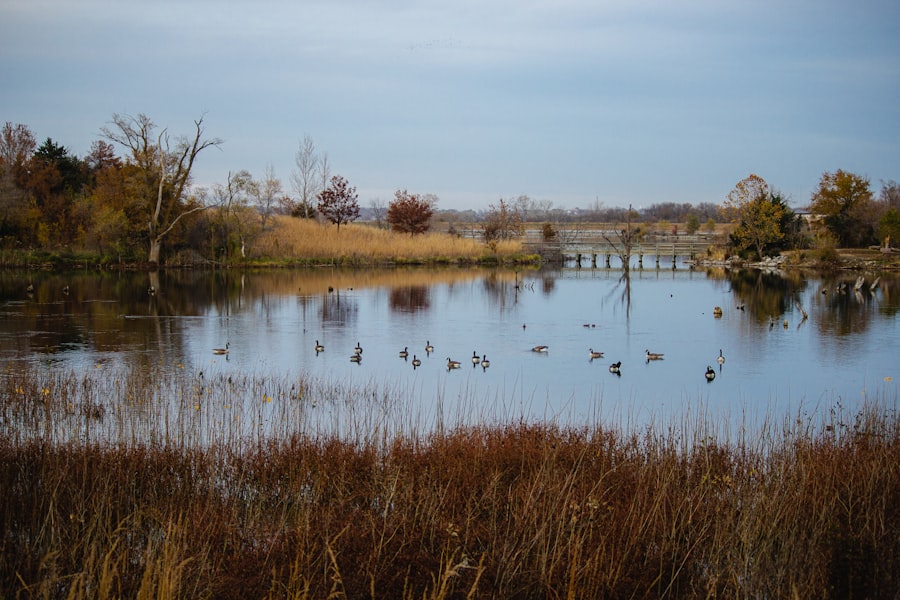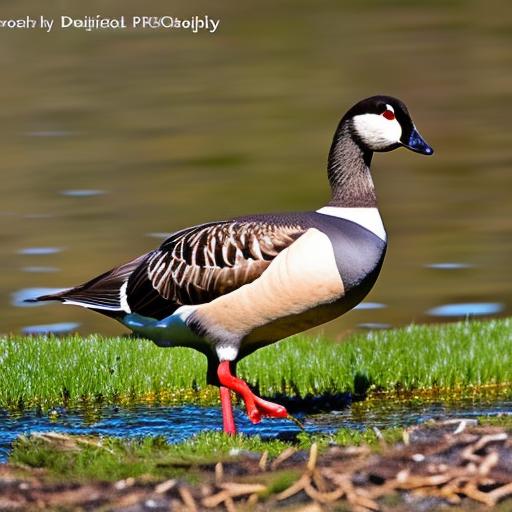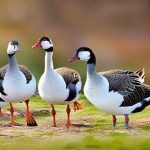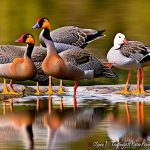Geese infestation is a common problem in many areas, causing damage to property, creating unsanitary conditions, and posing safety risks. Finding humane solutions to deter geese is crucial in order to address this issue effectively. It is important to strike a balance between protecting our environment and ensuring the well-being of these birds.
Key Takeaways
- Canadian geese are attracted to open spaces near water and grassy areas.
- Physical barriers such as fences and netting can prevent geese from accessing certain areas.
- Visual deterrents like decoys and reflective tape can scare geese away.
- Creating an unwelcoming environment by removing food sources and using landscaping techniques can discourage geese from staying.
- Sound devices like air horns and predator calls can be effective in scaring geese away.
Understanding the Behavior of Canadian Geese
Canadian geese are known for their strong homing instinct and their tendency to return to the same areas year after year. They are attracted to areas with open water, lush vegetation, and ample food sources. Understanding their behavior is key to finding effective deterrents.
Implementing Physical Barriers to Deter Geese
Physical barriers can be an effective way to deter geese from certain areas. Fencing, netting, and hedges are commonly used as physical barriers. Fencing can be used to create a physical barrier around ponds or other areas where geese tend to congregate. Netting can be placed over lawns or gardens to prevent geese from accessing these areas. Hedges can also serve as a natural barrier, making it difficult for geese to enter certain spaces.
While physical barriers can be effective, they also have some disadvantages. Fencing and netting can be expensive and may require regular maintenance. Hedges take time to grow and may not provide immediate results. Additionally, physical barriers may not be suitable for all areas or may not be aesthetically pleasing.
Utilizing Visual Deterrents to Repel Geese
Visual deterrents can be an effective way to repel geese from certain areas. These deterrents use visual stimuli that make the area appear unsafe or unwelcoming for geese. Examples of visual deterrents include scarecrows, reflective tape, and predator decoys.
Scarecrows can be placed in open areas to create the illusion of human presence, which can deter geese. Reflective tape can be hung from trees or poles to create a visual disturbance that scares geese away. Predator decoys, such as plastic owls or coyotes, can also be effective in deterring geese.
To use visual deterrents effectively, it is important to move them around periodically to prevent geese from becoming accustomed to them. Additionally, combining different types of visual deterrents can increase their effectiveness.
Creating Unwelcoming Environments for Geese
Creating an unwelcoming environment for geese is another effective way to deter them. This can be done by making the area less attractive to geese in terms of food and habitat. Removing or reducing food sources, such as grass clippings or fallen fruit, can discourage geese from staying in the area. Planting vegetation that is unpalatable to geese, such as prickly bushes or tall grasses, can also make an area less appealing.
Additionally, creating physical barriers within the environment, such as rocks or boulders, can make it difficult for geese to access certain areas. These barriers can be strategically placed around ponds or other areas where geese tend to congregate.
Implementing Sound Devices to Scare Geese Away

Sound devices can be an effective way to scare geese away from certain areas. These devices emit loud noises or predator calls that create a sense of danger for the geese. Examples of sound devices include propane cannons, ultrasonic devices, and bird distress calls.
Propane cannons produce loud bangs at regular intervals, simulating the sound of a gunshot and scaring geese away. Ultrasonic devices emit high-frequency sounds that are unpleasant for geese but not audible to humans. Bird distress calls mimic the sounds made by distressed birds, signaling danger to geese.
To use sound devices effectively, it is important to vary the timing and location of the sounds to prevent geese from becoming habituated to them. Additionally, it is important to consider the potential impact on other wildlife and nearby residents when using sound devices.
Using Repellents to Keep Geese off Land
Repellents can be an effective way to keep geese off land. These substances create an unpleasant taste or smell that deters geese from feeding or resting in the area. Examples of repellents include grape extract, methyl anthranilate, and garlic-based products.
Grape extract can be sprayed on grass or other vegetation to create a taste that geese find unappealing. Methyl anthranilate is a chemical compound that is used in some bird repellents and creates an unpleasant smell for geese. Garlic-based products can also be effective in repelling geese due to their strong odor.
To use repellents effectively, it is important to follow the instructions provided by the manufacturer. It is also important to reapply repellents regularly, especially after rainfall or irrigation.
Employing Motion-Activated Sprinklers to Deter Geese
Motion-activated sprinklers can be an effective way to deter geese from certain areas. These sprinklers are equipped with motion sensors that detect the presence of geese and activate a burst of water, scaring them away. Motion-activated sprinklers are particularly effective in areas where water is a major attractant for geese.
The advantages of using motion-activated sprinklers include their effectiveness in deterring geese and their low maintenance requirements. However, they may not be suitable for all areas, especially those with limited access to water or electricity.
Establishing Natural Predators to Keep Geese at Bay
Introducing natural predators can be an effective way to keep geese at bay. Predators such as dogs, hawks, or falcons can create a sense of danger for geese, making them less likely to stay in the area. These predators can be trained or used in a controlled manner to deter geese without causing harm.
To attract natural predators to an area, it is important to provide suitable habitat and food sources. For example, creating perches or nesting sites for birds of prey can encourage them to frequent the area. Additionally, providing a source of water or food for predators can help attract them to the area.
Implementing Habitat Modification to Discourage Geese
Modifying the habitat can be an effective way to discourage geese from staying in certain areas. This can be done by altering the landscape or vegetation to make it less attractive to geese. Examples of habitat modifications include installing floating islands, planting tall grasses, or creating steep slopes around ponds.
Floating islands can be placed in ponds to provide nesting sites for other bird species, which can deter geese from using the area. Planting tall grasses or creating steep slopes around ponds can make it difficult for geese to access the water, discouraging them from staying in the area.
Seeking Professional Help for Geese Management
In some cases, it may be necessary to seek professional help for geese management. This is especially true if other deterrent methods have been ineffective or if the infestation is severe. Professional geese management services have the expertise and resources to implement effective and humane solutions.
When seeking professional help, it is important to look for a service that has experience in geese management and uses humane methods. They should also have a good understanding of local regulations and guidelines regarding geese management.
In conclusion, finding humane solutions to deter geese is crucial in addressing the problem of geese infestation effectively. Understanding the behavior of Canadian geese and implementing a combination of physical barriers, visual deterrents, unwelcoming environments, sound devices, repellents, motion-activated sprinklers, natural predators, habitat modification, and professional help can help create a balance between protecting our environment and ensuring the well-being of these birds. It is important to find a solution that works for both humans and geese, promoting coexistence and harmony.
If you’re looking for effective ways to keep Canadian geese off your land, you might also be interested in learning about guinea fowl and their egg-laying habits. Guinea fowl are known to be excellent natural pest control agents, including deterring geese. To understand when guinea fowl lay eggs and how to breed them, check out this informative article on poultrywizard.com. Additionally, if you’re considering building a chicken coop to further protect your property, you can find valuable insights on nest box design and even a unique chicken coop trampoline concept at poultrywizard.com and poultrywizard.com respectively.
FAQs
What are Canadian geese?
Canadian geese are a species of waterfowl that are native to North America. They are known for their distinctive black heads and necks, white cheeks, and brown bodies.
Why do Canadian geese need to be kept off of land?
Canadian geese can cause damage to crops, lawns, and other vegetation. They can also be aggressive towards humans and pets, especially during nesting season.
What are some methods for keeping Canadian geese off of land?
Some methods for keeping Canadian geese off of land include using visual deterrents such as scarecrows or reflective tape, using noise deterrents such as air horns or barking dogs, and using physical barriers such as fences or netting.
Is it legal to harm or kill Canadian geese?
No, it is illegal to harm or kill Canadian geese without a permit from the appropriate wildlife agency. There are humane methods for managing Canadian geese populations that do not involve harming the birds.
What should I do if I encounter an injured or sick Canadian goose?
If you encounter an injured or sick Canadian goose, you should contact a local wildlife rehabilitation center or animal control agency for assistance. Do not attempt to handle the bird yourself, as it may be dangerous and could cause further harm to the bird.
Meet Walter, the feathered-friend fanatic of Florida! Nestled in the sunshine state, Walter struts through life with his feathered companions, clucking his way to happiness. With a coop that’s fancier than a five-star hotel, he’s the Don Juan of the chicken world. When he’s not teaching his hens to do the cha-cha, you’ll find him in a heated debate with his prized rooster, Sir Clucks-a-Lot. Walter’s poultry passion is no yolk; he’s the sunny-side-up guy you never knew you needed in your flock of friends!







